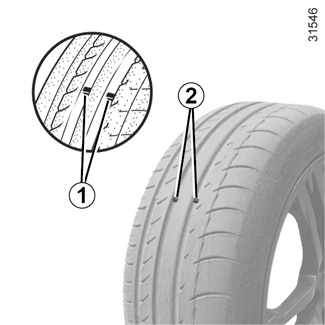TYRES
Tyre and wheel safety
The tyres are the only contact between the vehicle and the road, so it is essential to keep them in good condition. You must make sure that your tyres conform to local road traffic regulations.

Maintaining the tyres
The tyres must be in good condition and the tread form must have sufficient depth; tyres approved by our Technical Department have wear warning strips 1 which are indicators moulded into the tread at several points.
When the tyre tread has been worn to the level of the warning strips, they become visible 2: it is then necessary to replace your tyres because the tread rubber is now only 1.6 mm deep at most, resulting in poor road holding on wet roads.
An overloaded vehicle, long journeys by motorway, particularly in very hot weather, or continual driving on poorly surfaced minor roads will lead to more rapid tyre wear and affect safety.
Incidents which occur when driving, such as striking the kerb, may damage the tyres and wheel rims, and could also lead to misalignment of the front or rear axle geometry. In this case, have the condition of these checked by an approved dealer.
Tyre pressures
Adhere to the tyre pressures. The tyre pressures should be checked at least once a month and additionally before any long journey (refer to the label affixed to the edge of the driver’s door).
The pressures should be checked cold: ignore higher pressures which may be reached in hot weather or following a high speed journey.
Incorrect tyre pressures lead to abnormal tyre wear and unusually hot running. These are factors which may seriously affect safety and lead to:
- poor road holding,
- risk of bursting or tread separation.
The pressure depends on the load and the speed of use. Adjust the pressure according to the conditions of use (refer to the label affixed to the edge of the driver’s door).
If the pressures cannot be checked when the tyres are cold, increase the pressures from 0.2 to 0.3 bar (or 3 PSI).
Never deflate a hot tyre.
Changing wheels around
The front and rear wheels have different dimensions. For safety reasons, it is not permitted to switch the front wheels (tyres and/or rims) with the rear wheels.
Please be aware that a poorly tightened or missing valve cap can make the tyres less airtight and lead to pressure loss.
Always use valve caps identical to those fitted originally and tighten them fully.
Vehicle fitted with a tyre pressure loss warning system
If under-inflated (puncture, low pressure etc.), the warning light on the instrument panel comes on. See “Tyre pressure loss warning” in Section 2.
Fitting new tyres
For your safety reasons.
Only tyres identical to those fitted originally or recommended by an approved dealer must be used.
Failure to follow these instructions could endanger your safety.
This could adversely affect stability, behaviour, braking or the clearance between the bodywork and the tyres.
Some of these effects could lead to the loss of control of the vehicle under certain driving conditions.
For your safety, please respect the speed limit.
When they need to be replaced, only tyres of the same make, size, type and profile should be used on a single axle.
They must have a load capacity and speed rating at least equal to those of the original tyres and correspond to the tyres recommended by an approved Dealer.
Failure to heed these instructions could endanger your safety and affect your vehicle’s roadworthiness.
Risk of loss of control of the vehicle.
Use in winter
Chains
For safety reasons, only fit chains on the rear axle.
Chains must not be fitted to tyres which are larger than those originally fitted to the vehicle.
Chains may only be fitted to tyres of the same size as those originally fitted to your vehicle.
16” and 17” wheels can only be fitted with chains in conjunction with specific devices or equipment, consult an approved Dealer.
Snow or winter tyres
In the interests of safety (vehicle traction quality), equip all four wheels of the vehicle.
Warning: These tyres sometimes have a specific direction of rotation and a maximum speed index which may be lower than the maximum speed of your vehicle.
Studded tyres
This type of equipment may only be used for a limited period and as laid down by local legislation. It is necessary to observe the speed specified by current legislation.
These tyres must be fitted to all four wheels of the vehicle.
In all cases, we would recommend that you contact an approved dealer who will be able to advise you on the choice of equipment which is most suitable for your vehicle.